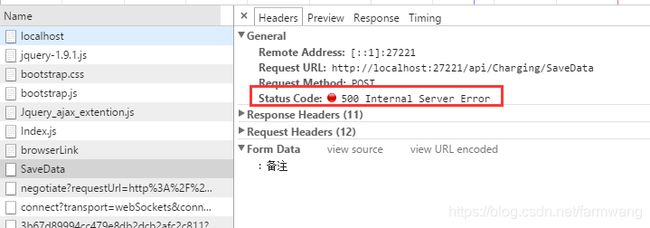WebApi 接口参数不再困惑:传参详解 Post
post请求
在WebApi的RESETful风格里面,API服务的增删改查,分别对应着http的post/delete/put/get请求。我们下面就来说说post请求参数的传递方式。
回到顶部
1、基础类型参数
post请求的基础类型的参数和get请求有点不一样,我们知道get请求的参数是通过url来传递的,而post请求则是通过http的请求体中传过来的,WebApi的post请求也需要从http的请求体里面去取参数。
(1)错误的写法
$.ajax({
type: "post",
url: "http://localhost:27221/api/Charging/SaveData",
data: { NAME: "Jim" },
success: function (data, status) {
if (status == "success") {
$("#div_test").html(data);
}
}
});
[HttpPost]
public bool SaveData(string NAME)
{
return true;
}(2)正确的用法
$.ajax({
type: "post",
url: "http://localhost:27221/api/Charging/SaveData",
data: { "": "Jim" },
success: function (data, status) {}
});
[HttpPost]
public bool SaveData([FromBody]string NAME)
{
return true;
}这是一种另许多人头痛的写法,但是没办法,这样确实能得到我们的结果:
我们一般的通过url取参数的机制是键值对,即某一个key等于某一个value,而这里的FromBody和我们一般通过url取参数的机制则不同,它的机制是=value,没有key的概念,并且如果你写了key(比如你的ajax参数写的{NAME:"Jim"}),后台反而得到的NAME等于null。不信你可以试试。
上面讲的都是传递一个基础类型参数的情况,那么如果我们需要传递多个基础类型呢?按照上面的推论,是否可以([FromBody]string NAME, [FromBody]string DES)这样写呢。试试便知。
(1)错误写法
$.ajax({
type: "post",
url: "http://localhost:27221/api/Charging/SaveData",
data: { "": "Jim","":"备注" },
success: function (data, status) {}
});
[HttpPost]
public bool SaveData([FromBody]string NAME, [FromBody] string DES)
{
return true;
}这说明我们没办法通过多个[FromBody]里面取值,此法失败。
(2)正确用法
既然上面的办法行不通,那我们如何传递多个基础类型的数据呢?很多的解决办法是新建一个类去包含传递的参数,博主觉得这样不够灵活,因为如果我们前后台每次传递多个参数的post请求都去新建一个类的话,我们系统到时候会有多少个这种参数类?维护起来那是相当的麻烦的一件事!所以博主觉得使用dynamic是一个很不错的选择。我们来试试。
$.ajax({
type: "post",
url: "http://localhost:27221/api/Charging/SaveData",
contentType: 'application/json',
data: JSON.stringify({ NAME: "Jim",DES:"备注" }),
success: function (data, status) {}
});
[HttpPost]
public object SaveData(dynamic obj)
{
var strName = Convert.ToString(obj.NAME);
return strName;
}通过dynamic动态类型能顺利得到多个参数,省掉了[FromBody]这个累赘,并且ajax参数的传递不用使用"无厘头"的{"":"value"}这种写法,有没有一种小清新的感觉~~有一点需要注意的是这里在ajax的请求里面需要加上参数类型为Json,即 contentType: 'application/json', 这个属性。
(3)推荐用法
通过上文post请求基础类型参数的传递,我们了解到了dynamic的方便之处,为了避免[FromBody]这个累赘和{"":"value"}这种"无厘头"的写法。博主推荐所有基础类型使用dynamic来传递,方便解决了基础类型一个或多个参数的传递,示例如上文。如果园友们有更好的办法,欢迎讨论。
2、实体作为参数
(1)单个实体作为参数
上面我们通过dynamic类型解决了post请求基础类型数据的传递问题,那么当我们需要传递一个实体作为参数该怎么解决呢?我们来看下面的代码便知:
$.ajax({
type: "post",
url: "http://localhost:27221/api/Charging/SaveData",
data: { ID: "1", NAME: "Jim", CREATETIME: "1988-09-11" },
success: function (data, status) {}
});
[HttpPost]
public bool SaveData(TB_CHARGING oData)
{
return true;
}得到结果
原理解释:使用实体作为参数的时候,前端直接传递普通json,后台直接使用对应的类型去接收即可,不用FromBody。但是这里需要注意的一点就是,这里不能指定contentType为appplication/json,否则,参数无法传递到后台。我们来看看它默认的contentType是什么:
为了弄清楚原因,博主查了下http的Content-Type的类型。看到如下说明:
- application/x-www-form-urlencoded :
- application/json : JSON数据格式
也就是说post请求默认是将表单里面的数据的key/value形式发送到服务,而我们的服务器只需要有对应的key/value属性值的对象就可以接收到。而如果使用application/json,则表示将前端的数据以序列化过的json传递到后端,后端要把它变成实体对象,还需要一个反序列化的过程。按照这个逻辑,那我们如果指定contentType为application/json,然后传递序列化过的对象应该也是可以的啊。博主好奇心重,还是打算一试到底,于是就有了下面的代码:
var postdata = { ID: "1", NAME: "Jim", CREATETIME: "1988-09-11" };
$.ajax({
type: "post",
url: "http://localhost:27221/api/Charging/SaveData",
contentType: 'application/json',
data: JSON.stringify(postdata),
success: function (data, status) {}
});
[HttpPost]
public bool SaveData(TB_CHARGING lstCharging)
{
return true;
}尝试成功,也就是说,两种写法都是可行的。如果你指定了contentType为application/json,则必须要传递序列化过的对象;如果使用post请求的默认参数类型,则前端直接传递json类型的对象即可。
(2)实体和基础类型一起作为参数传递
有些时候,我们需要将基础类型和实体一起传递到后台,这个时候,我们神奇的dynamic又派上用场了。
var postdata = { ID: "1", NAME: "Jim", CREATETIME: "1988-09-11" };
$.ajax({
type: "post",
url: "http://localhost:27221/api/Charging/SaveData",
contentType: 'application/json',
data: JSON.stringify({ NAME:"Lilei", Charging:postdata }),
success: function (data, status) {}
});
[HttpPost]
public object SaveData(dynamic obj)
{
var strName = Convert.ToString(obj.NAME);
var oCharging = Newtonsoft.Json.JsonConvert.DeserializeObject(Convert.ToString(obj.Charging));
return strName;
} 3、数组作为参数
(1)基础类型数组
![]()
var arr = ["1", "2", "3", "4"];
$.ajax({
type: "post",
url: "http://localhost:27221/api/Charging/SaveData",
contentType: 'application/json',
data: JSON.stringify(arr),
success: function (data, status) { }
});
![]()
[HttpPost]
public bool SaveData(string[] ids)
{
return true;
}
2)实体集合
![]()
var arr = [
{ ID: "1", NAME: "Jim", CREATETIME: "1988-09-11" },
{ ID: "2", NAME: "Lilei", CREATETIME: "1990-12-11" },
{ ID: "3", NAME: "Lucy", CREATETIME: "1986-01-10" }
];
$.ajax({
type: "post",
url: "http://localhost:27221/api/Charging/SaveData",
contentType: 'application/json',
data: JSON.stringify(arr),
success: function (data, status) {}
});
![]()
[HttpPost]
public bool SaveData(List lstCharging)
{
return true;
}
4、后台发送请求参数的传递
上面写了那么多,都是通过前端的ajax请求去做的,我们知道,如果调用方不是web项目,比如Android客户端,可能需要从后台发送http请求来调用我们的接口方法,如果我们通过后台去发送请求是否也是可行的呢?我们以实体对象作为参数来传递写写代码试一把。
public void TestReques()
{
//请求路径
string url = "http://localhost:27221/api/Charging/SaveData";
//定义request并设置request的路径
WebRequest request = WebRequest.Create(url);
request.Method = "post";
//初始化request参数
string postData = "{ ID: \"1\", NAME: \"Jim\", CREATETIME: \"1988-09-11\" }";
//设置参数的编码格式,解决中文乱码
byte[] byteArray = Encoding.UTF8.GetBytes(postData);
//设置request的MIME类型及内容长度
request.ContentType = "application/json";
request.ContentLength = byteArray.Length;
//打开request字符流
Stream dataStream = request.GetRequestStream();
dataStream.Write(byteArray, 0, byteArray.Length);
dataStream.Close();
//定义response为前面的request响应
WebResponse response = request.GetResponse();
//获取相应的状态代码
Console.WriteLine(((HttpWebResponse)response).StatusDescription);
//定义response字符流
dataStream = response.GetResponseStream();
StreamReader reader = new StreamReader(dataStream);
string responseFromServer = reader.ReadToEnd();//读取所有
Console.WriteLine(responseFromServer);
}当代码运行到request.GetResponse()这一句的时候,API里面进入断点









